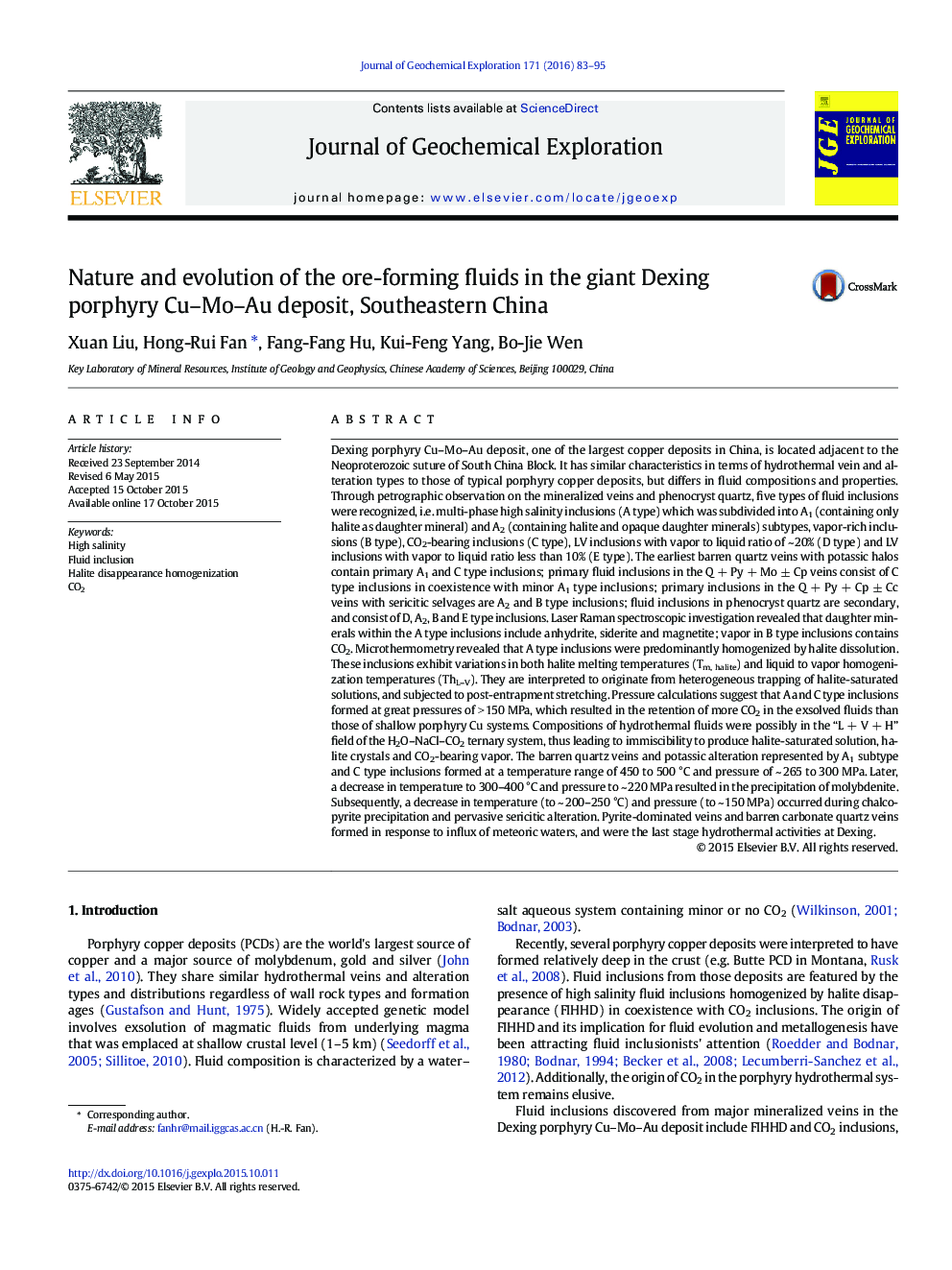| کد مقاله | کد نشریه | سال انتشار | مقاله انگلیسی | نسخه تمام متن |
|---|---|---|---|---|
| 5754475 | 1620888 | 2016 | 13 صفحه PDF | دانلود رایگان |

- High salinity fluid inclusions at Dexing were homogenized by halite disappearance.
- Ore-forming fluids of Dexing deposit contain significant amounts of CO2.
- Homogenization temperature variations for high saline inclusions were interpreted.
- High pressure (>Â 150Â MPa) was the dominant cause for retention of CO2 in porphyry magmas.
- Fluid unmixing and P-T decrease were responsible for Cu and Mo mineralization.
Dexing porphyry Cu-Mo-Au deposit, one of the largest copper deposits in China, is located adjacent to the Neoproterozoic suture of South China Block. It has similar characteristics in terms of hydrothermal vein and alteration types to those of typical porphyry copper deposits, but differs in fluid compositions and properties. Through petrographic observation on the mineralized veins and phenocryst quartz, five types of fluid inclusions were recognized, i.e. multi-phase high salinity inclusions (A type) which was subdivided into A1 (containing only halite as daughter mineral) and A2 (containing halite and opaque daughter minerals) subtypes, vapor-rich inclusions (B type), CO2-bearing inclusions (C type), LV inclusions with vapor to liquid ratio of ~ 20% (D type) and LV inclusions with vapor to liquid ratio less than 10% (E type). The earliest barren quartz veins with potassic halos contain primary A1 and C type inclusions; primary fluid inclusions in the Q + Py + Mo ± Cp veins consist of C type inclusions in coexistence with minor A1 type inclusions; primary inclusions in the Q + Py + Cp ± Cc veins with sericitic selvages are A2 and B type inclusions; fluid inclusions in phenocryst quartz are secondary, and consist of D, A2, B and E type inclusions. Laser Raman spectroscopic investigation revealed that daughter minerals within the A type inclusions include anhydrite, siderite and magnetite; vapor in B type inclusions contains CO2. Microthermometry revealed that A type inclusions were predominantly homogenized by halite dissolution. These inclusions exhibit variations in both halite melting temperatures (Tm, halite) and liquid to vapor homogenization temperatures (ThL-V). They are interpreted to originate from heterogeneous trapping of halite-saturated solutions, and subjected to post-entrapment stretching. Pressure calculations suggest that A and C type inclusions formed at great pressures of > 150 MPa, which resulted in the retention of more CO2 in the exsolved fluids than those of shallow porphyry Cu systems. Compositions of hydrothermal fluids were possibly in the “L + V + H” field of the H2O-NaCl-CO2 ternary system, thus leading to immiscibility to produce halite-saturated solution, halite crystals and CO2-bearing vapor. The barren quartz veins and potassic alteration represented by A1 subtype and C type inclusions formed at a temperature range of 450 to 500 °C and pressure of ~ 265 to 300 MPa. Later, a decrease in temperature to 300-400 °C and pressure to ~ 220 MPa resulted in the precipitation of molybdenite. Subsequently, a decrease in temperature (to ~ 200-250 °C) and pressure (to ~ 150 MPa) occurred during chalcopyrite precipitation and pervasive sericitic alteration. Pyrite-dominated veins and barren carbonate quartz veins formed in response to influx of meteoric waters, and were the last stage hydrothermal activities at Dexing.
Journal: Journal of Geochemical Exploration - Volume 171, December 2016, Pages 83-95